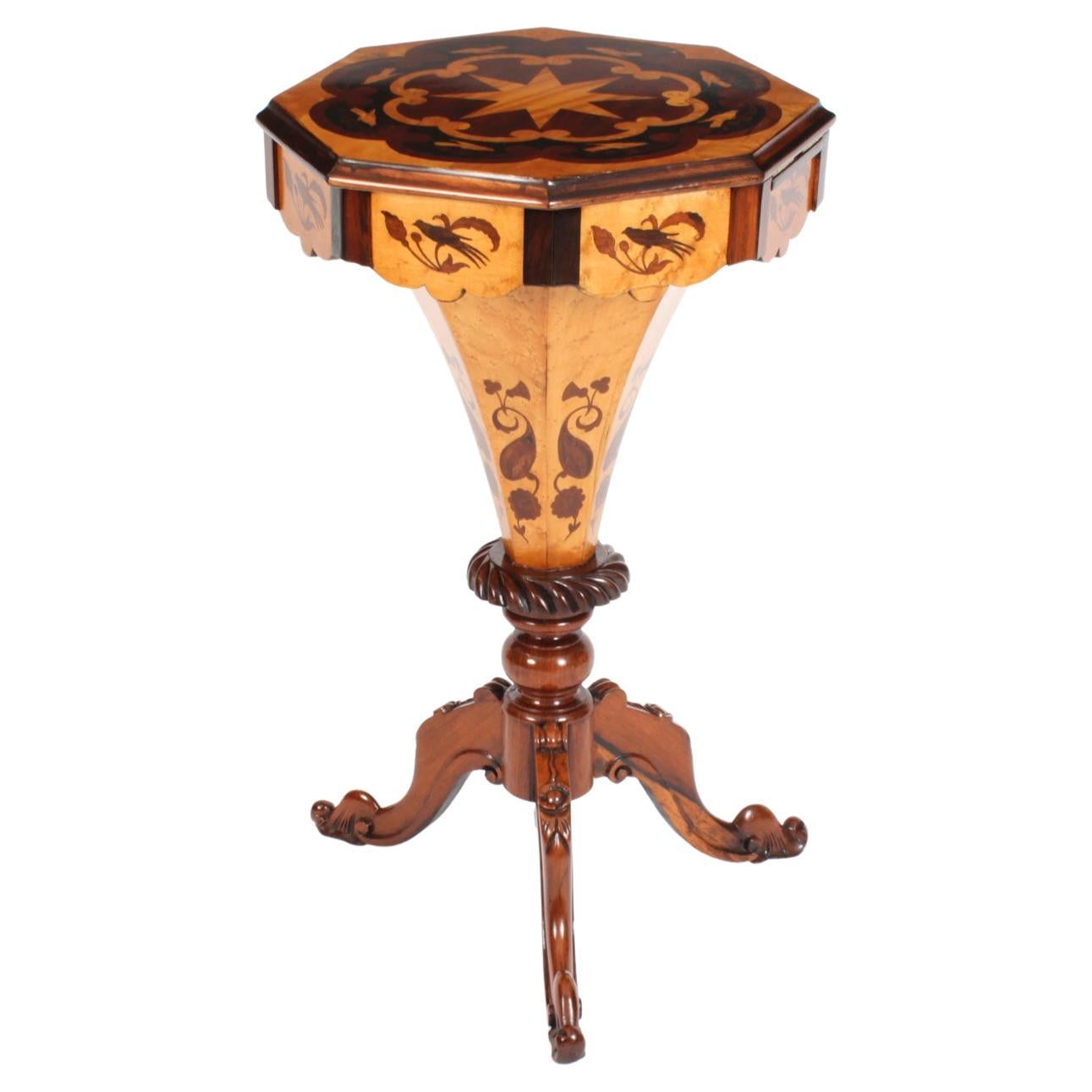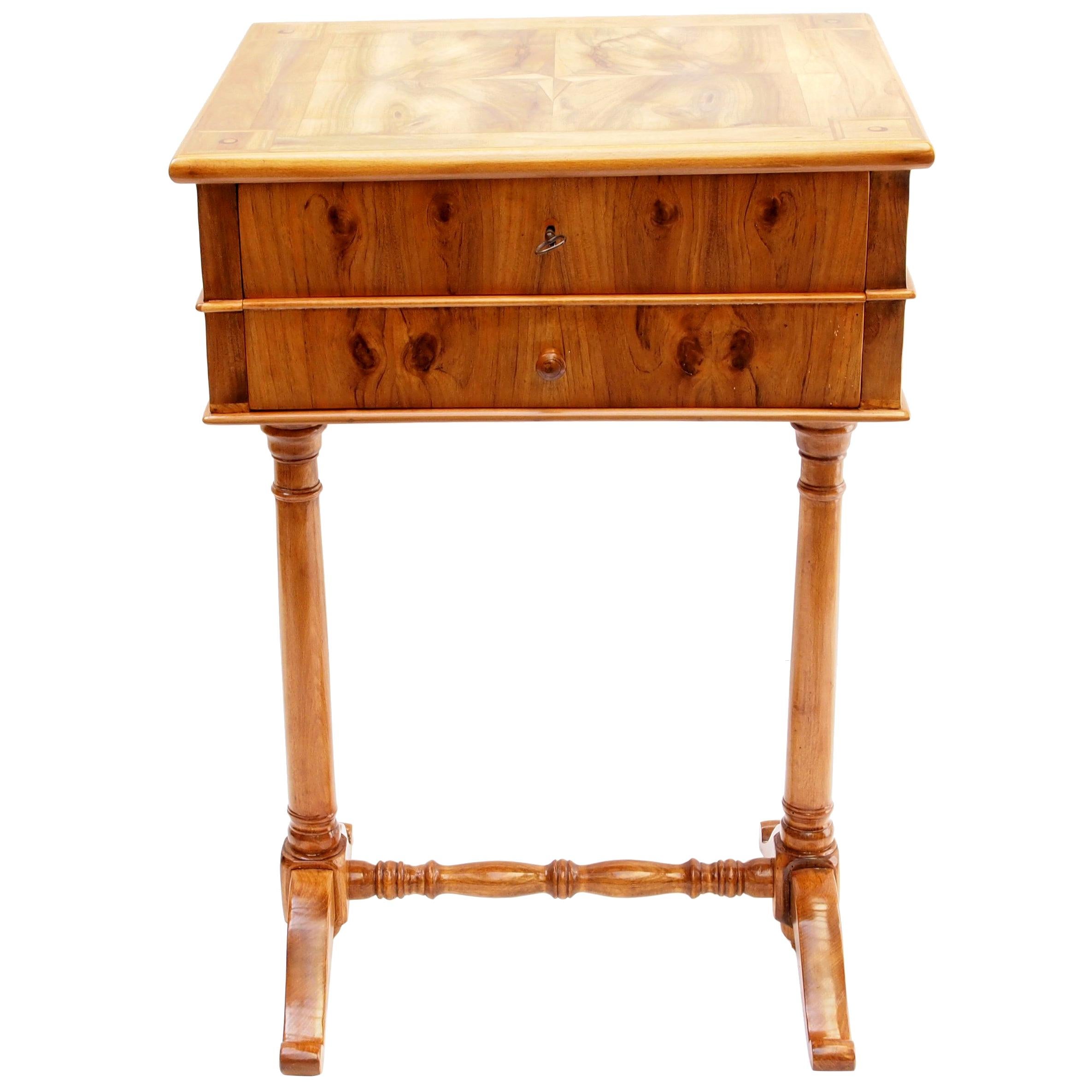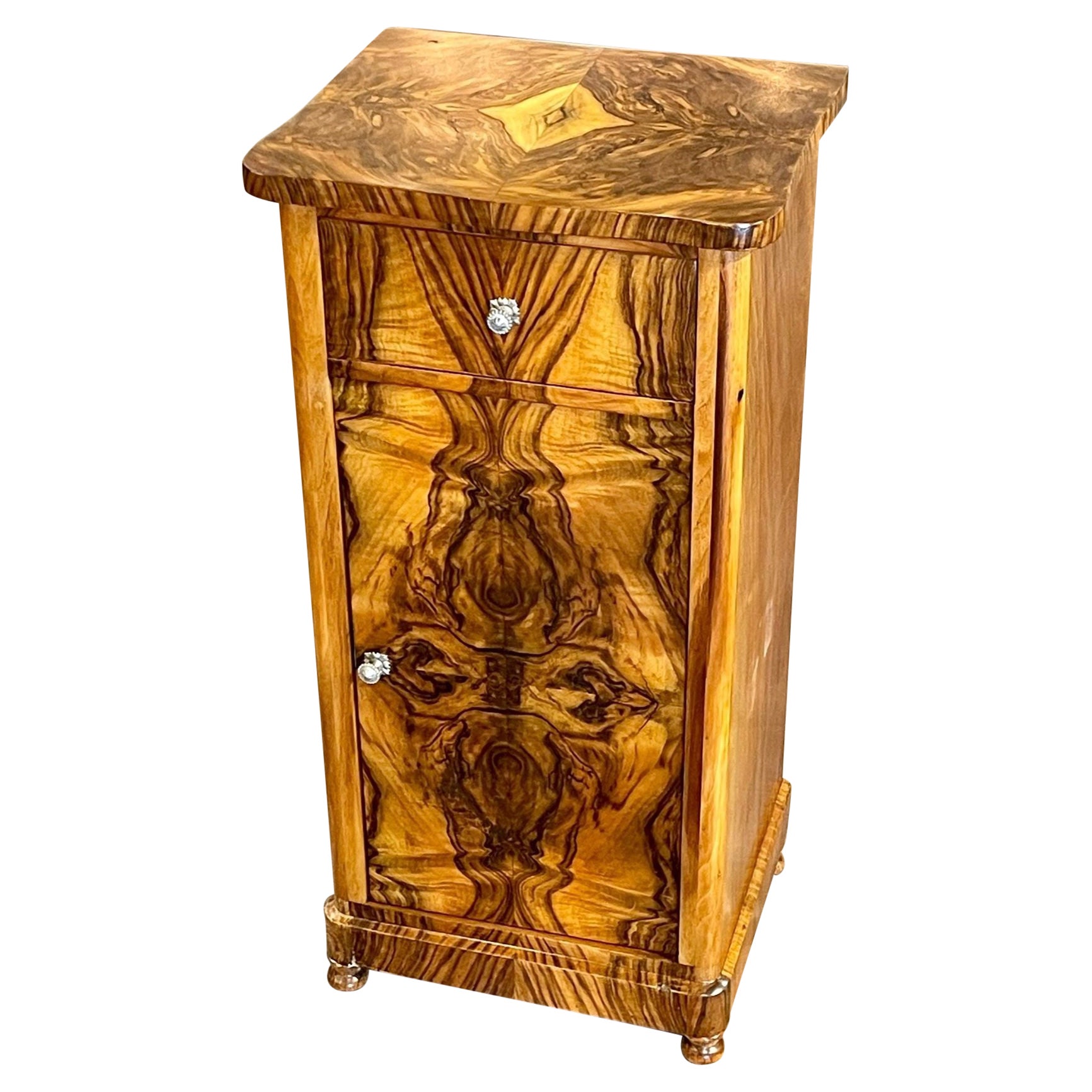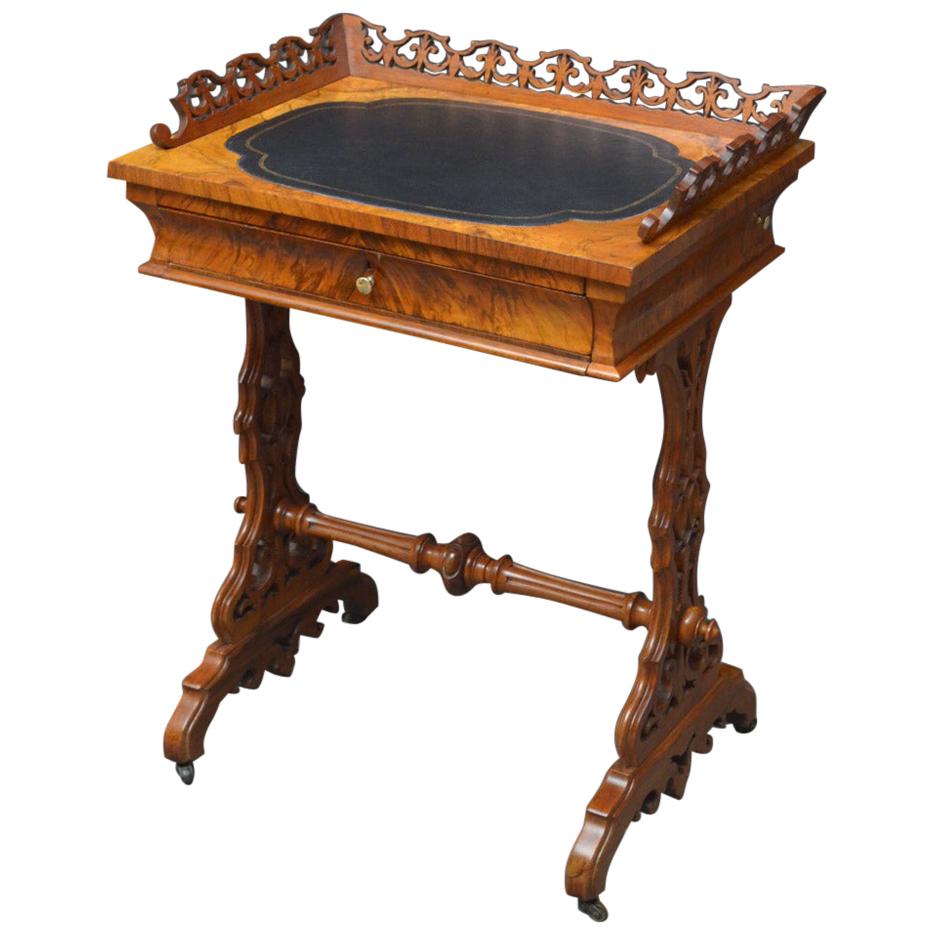Items Similar to 19th Century French Carved Walnut Sewing Work Stand Quilt Rack
Want more images or videos?
Request additional images or videos from the seller
1 of 21
19th Century French Carved Walnut Sewing Work Stand Quilt Rack
About the Item
A rare and unusual antique circa 1870s French trestle-form sewing work stand / quilt rack with beautifully aged heavily worn patina.
France, late 19th century, hand-crafted of solid walnut, having an upholstered padded top rail, over open trough storage, on fluted supports decorated with intricate hand carved acanthus leaves, joined by single cross stretcher, ending in scroll feet.
Dimensions: (approx)
33.25" High, 32" Wide, 16" Deep
Today, it would make for a wonderful blanket stand, quilt display, towel holder, valet, and more
Condition:
Good original unrestored antique condition with beautifully aged warm rustic heavily worn distressed patina. Structurally sound but with warping. Lots of antique character and charm, sure to add sophisticated elegance and warmth to any space!
- Dimensions:Height: 33.25 in (84.46 cm)Width: 32 in (81.28 cm)Depth: 16 in (40.64 cm)
- Style:Rococo (In the Style Of)
- Materials and Techniques:
- Place of Origin:
- Period:
- Date of Manufacture:circa 1870s
- Condition:Wear consistent with age and use. Minor losses. Minor structural damages. Minor fading. Good original unrestored antique condition w/beautifully aged warm rustic heavily worn distressed patina. Structurally sound but with warping. Not square. Lots of antique character & charm, sure to add sophisticated elegance and warmth to any space!
- Seller Location:Forney, TX
- Reference Number:1stDibs: LU5977236683162
About the Seller
4.8
Platinum Seller
These expertly vetted sellers are 1stDibs' most experienced sellers and are rated highest by our customers.
Established in 2013
1stDibs seller since 2021
200 sales on 1stDibs
Typical response time: <1 hour
- ShippingRetrieving quote...Ships From: Forney, TX
- Return PolicyA return for this item may be initiated within 7 days of delivery.
More From This SellerView All
- 19th C. French Charles X Restoration Period Sewing Stand Work TableLocated in Forney, TXA scarce period Charles X (1818-1834) French Restoration mahogany travailleuse sewing (thread stand - side table - jewelry dressing table) with light, warm, beautifully aged patina. Born in France in the early 19th century, almost certainly Parisian work, exquisitely hand-crafted, this exceptionally executed example features ornate gilt bronze ormolu mounts, escutcheons, and elaborate gilt metal trim. Having a highly figured light mahogany hinged lid top, lifting open to reveal a striking finished interior with divided compartments and original inset mirror plate. The conforming rectangular case fitted with a faux drawer front over a dovetailed drawer with sectioned interior. Elegantly rising on oval-shaped medial shelf stretcher-joined curvacious legs. Dimensions (approx): 27" High, 20" Wide, 13.5" Deep Stunning light almost blonde antique mahogany coloring and mellow warm tone, superb wood grain detail, and charming, beautifully aged patina over the whole. Great shape overall. Retaining original antique character marks, wear consistent with age and indicative of minimal use, nothing that detracts from the aesthetics or functionality, but only adds to the overall authenticity, refined elegant warmth, luxurious sophistication, and cozy unpretentious rustic elegance. Delivered cleaned, hand waxed, polished French patina finish, ready for immediate use and generational enjoyment! What is Charles X style: The comte d’Artois – or Charles X - was the son of the dauphin Louis-Ferdinand de Franc and Marie-Josèphe de Saxe. He succeeded his two brothers Louis XVI and Louis XVIII and became the King of France in 1824. Thirty years after the French Revolution, he wanted to embody the return of monarchy and became the leader of the catholic party . As the previous kings, he was crowned in 1825 but he was soon overthrown by the revolution in July, 1830, called "Trois Glorieuses". He left then for England, Scotland, Prague and Istria where he died in 1836. Charles X style lasted from 1818 to 1834 and happened during the Bourbon Restoration (French Restoration). This style did not replace totally the style of furniture from the French Empire but it was different from the formalism in the Napoleonic era, during which strictness and simplicity were inspired by Greco-Roman art. Indeed, artistic fields flourished. In terms of furniture, this renewal was suggested by the softening of shapes. Even though the simple aspect from the French Empire was still visible, shapes became curvier with volutes and arabesques. Another distinction is the loss of the massive aspect of furniture and the decrease of dimensions in order to decorate smaller appartments. Handling ability and comfort were key-words in the making of furniture. Apartments had essential elements such as chests of drawers, big rounded tables in the dining room, desks or secretaries, armoires and even dressing tables, comfortable fainting couches in the living room, small tables, pedestal tables, as well as gondola chairs. The wavy aspect of the latters certainly represent Charles X style the best. One of the most emblematic features of this style is the use of bois clairs – light woods in warm blond tones - and indigenous woods that are varnished in order to highlight the grains. Bird's-eye maple, ash trees, plane trees, yew trees, beech trees, olive trees and cedar trees were most likely to be used. Indeed, at the beginning of the 19th century dark woods were hard to find. In 1806, the Napoleon’s Continental System was established in order to ruin the United Kingdom by preventing the country from any business with the rest of Europe. Therefore craftsmen had to find alternatives from mahogany which was the most commonly used material at this time. After 1815, the import of wood was even more difficult because of peace treaties and the European political situation, which contributed to the popularity of the bois clairs and indigenous woods. The furniture was often decorated with fine inlays made out of dark wood representing foliage, which contrasted with the veneer. Even though these patterns can look like bronze decorations from the Empire era, they were far more simple and did not represent any military or mythological attributes. On the tables, trays were sometimes made out of marble as in the French Empire, but it was often put aside and inlaid veneer, Verre Eglomisé – a type of glass with a mirror finish –, mirror or porcelain from Sèvres or Paris were more likely to be used. Decorative elements from the Monarchy were highly appreciated again as they suggested luxury. Indeed, marquetry work was particularly fashionable - Boulle marquetry thrived around 1820 as the works of the Levasseur family can show. In the same way, draperies and trimmings referred to the monarchist splendour. Fabrics were often white – the traditional colour of the Bourbons – or light coloured as oppposed to the typical green from the Napoleonic era. One of the most symbolic figures from this period of time might be Jean-Jacques Werner (1791-1849), a cabinetmaker who worked for prestigious clients such as the Duchesse de Berry who was Charles’s step-daughter. His works can be seen at the Musée des Arts Décoratifs and at the Grand Trianon in the Palace of Versailles. The duchess’s appartments situated at the pavillon de Marsan and at the Palais de Saint Cloud illustrate Charles X style the best with furniture made out of bois clairs and ornamented with dark wood patterns or fine gold decorations. Chales X style allows a transition between the sobriety of the Empire style and the abundant aspect of Louis-Philippe style. The gothic style started at this time through the "style à la cathédrale", inspired by religious architecture, which thrived from 1827 to 1830. Indeed, at the beginning of the 19th century, Romanticism put the spotlight on the Middle Ages. Cabinetmakers were not inspired by the medieval furniture but rather by architectural elements of churches and cathedrals. For instance the backs of chairs were decorated with arches shaped like rib and serration. In the same way, before Charles X abdicated, pieces of furniture were made out of dark woods – such as mahogany, which was used again in France – and were inlaid with light wood. Romanticism also influenced the layout of furniture in appartments to suggest movement through a mix of various styles, various shapes and various sizes, as opposed to the static aspect of Neoclassicism. The start of industrialisation and mechanisation also influenced this style as early technical developments led to the production of pieces of furniture in series. Credit: Marc Maison Bibliography: FANIEL Stéphane (Dir.), Le Dix-neuvième Siècle Français, Collection Connaissance des Arts, 1957, Hachette SASSONE, Adriana Boidi, Furniture from Rococo to Art Deco, 2000, Evergreen -- Extremely versatile: As warm and attractive as it is useful, this remarkable antique table having the ideal size and small proportions for a variety of different uses, including as a side table, accent or occasional table, tall sofa...Category
Antique Early 19th Century French Charles X End Tables
MaterialsBronze, Ormolu
- William IV Period English Sewing Stand Work TableLocated in Forney, TXA scarce nearly 200 year old English William IV Period rosewood and mahogany sewing stand work table with beautifully aged warm rustic patina. circa 1830s Combining sophisticated e...Category
Antique Mid-19th Century English William IV Side Tables
MaterialsFabric, Upholstery, Mahogany, Rosewood
- Early 19th Century English Regency Period Sewing TableLocated in Forney, TXAn elegant Regency period English mahogany and rosewood work table, circa 1815, in the manner of Gillows, having an attractive flame mahogany top with rope trim detail, above a singl...Category
Antique Early 19th Century Regency Side Tables
MaterialsMahogany, Rosewood, Fabric
- 19th Century French Rocaille Louis XV Style Portfolio StandLocated in Forney, TXA rare late 19th century carved mahogany French Louis XV style portfolio table / sheet music stand. Exquisitely handcrafted and elegantly finished in timeless Rocaille taste. A classic representation of the genre, with serpentine shaped molded edge parquetry top of matched diamond pattern inlay, supported by a finely hand carved, scrolled and scalloped apron and single frieze drawer with original asymmetrical gilt ormolu pull, over a conforming contoured shelf and open gallery of vertical slots for sheet music, books, magazines, letters, documents and whatnots, all raised by four long cabriole leg wonderfully carved with complementary motifs. In excellent condition, exceptional craftsmanship and detail, having warm, rich antique mahogany color...Category
Antique 19th Century Louis XV End Tables
MaterialsOrmolu
- Early 19th Century American Federal Period Work TableLocated in Forney, TXA rare and very fine quality classical American Federal period side table / worktable with beautiful, warm rich patina. Circa 1820 Exquisitely hand-crafted in the early 19th centu...Category
Antique Early 19th Century American Federal End Tables
MaterialsMahogany
- Early American Classical Empire Period Flame Mahogany Sewing Stand Work TableLocated in Forney, TXA rare fine quality Federal period American Empire flame mahogany sewing stand work table from the early 19th century. Exquisitely hand-crafted in the northeastern United States, most likely Philadelphia, Pennsylvania, circa 1820, having a hinged top, opening to reveal contrasting Birdseye maple marquetry oval cartouche inlay, a fitted maple divided compartment interior, the front having two nicely shaped curved drawer fronts, consisting of a faux drawer front over a single dovetailed ogee drawer, above a vasiform pedestal standard, molded stepped platform base, rising on bracket feet, resting on casters. Attractive highly figured crotch cut swirl mahogany with striking grain patterns, rich and deep antique wood color...Category
Antique Early 19th Century American Empire Side Tables
MaterialsBirdseye Maple, Mahogany
You May Also Like
- 19th Century Mahogany Sewing Stand/Work TableLocated in Nantucket, MA19th century Mahogany sewing stand or work table. Upper three-sided gallery top with finger cutouts on sides above storage compartment with accordion style sliding door, with single...Category
Antique Late 19th Century Side Tables
MaterialsBrass
- 19th century French kingwood sewing work tableLocated in Debenham, SuffolkGood quality french 19th century work table circa 1870. Shaped top surface with chequered pattern in kingwood and tuilpwood, with ormolu edging. Further mounts to the drawer fronts...Category
Antique Late 19th Century French Victorian Side Tables
MaterialsKingwood
- Antique Burr Walnut & Birdseye Maple Work Sewing Box 19th CenturyLocated in London, GBA superb burr walnut and birdseye maple marquetry work / sewing table, Circa 1860 in date The ornately floral marquetry inlaid octagonal hinged top with a central star motif within ...Category
Antique 1860s Side Tables
MaterialsWalnut
- 19th Century Biedermeier Walnut Sewing Table from GermanyLocated in Darmstadt, DEBeautiful Biedermeier walnut sewing table with two drawers and the original interior division. In very good restored condition.Category
Antique Early 19th Century German Biedermeier Side Tables
MaterialsWalnut
- 19th Century German Biedermeier Walnut StandLocated in Dallas, TXHandsome German Biedermeier book matched black walnut stand. Beautiful wood grain and finish. And there is a shelf inside for storage. Makes a very fi...Category
Antique 19th Century German Biedermeier Side Tables
MaterialsWalnut
- 19th Century Walnut Games and Work TableLocated in Whaley Bridge, GBSn4628, unusual 19th century figured walnut writing table with side drawer, having fretwork gallery and leather writing surface to the top, above a concave drawer...Category
Antique 1880s European Victorian Game Tables
MaterialsWalnut
Recently Viewed
View AllMore Ways To Browse
Wicker Ghost
Wolfgang Hoffman Table
Yellow Parsons Table
Alexander Girard Braniff
Antique Farmhouse Nightstand
Borsani T1 Table
Borsani T1
Brighton Bamboo Table
Flos Overlap
French Cherry Deco Side Table
Hay Tray Table
Iphone 12 Pro
Karl Springer Sculpture Side Table
Knoll Tripod Table
Natalie Tredgett
Profiterole Occasional Table Lara Bohinc
Profiterole Occasional Table
Shagreen Drinks Table





